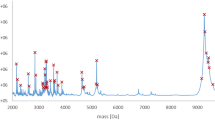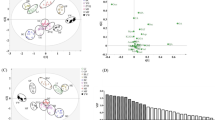Abstract
Chinese dark tea (CDT) was investigated for chemical characteristics using liquid chromatography coupled with tandem mass spectrometry (LC-MS) metabolomics analysis. The LC-MSn method was used for detection of secondary metabolites in 10 CDT varieties. Pattern recognition methods, including principal component analysis (PCA) and orthogonal projection on latent structure-discriminant analysis (OPLS-DA), revealed clear differences and classified the CDT varieties into 2 categories. One category is fermented with Aspergillus niger while the other (fu teas) is fermented with Eurotium cristatum. Chemical analyses identified 25 marker compounds that contribute to the classification of the 2 CDT types. Flavonoid triglycosides and catechin derivatives were the distinctive compounds of fu teas, based on MS/MS fragmentation analysis. Although both fu teas and dark teas are commonly called CDTs, differences between these two CDT types are significant in the chemical classification.
Similar content being viewed by others
References
Cao ZH, Gu DH, Lin QY, Xu ZQ, Huang QC, Rao H, Liu EW, Jia JJ, Ge CR. Effect of pu-erh tea on body fat and lipid profiles in rats with diet-induced obesity. Phytother. Res. 25: 234–238 (2011)
Oi Y, Hou IC, Fujita H, Yazawa K. Antiobesity effects of Chinese black tea (pu-erh tea) extract and gallic acid. Phytother. Res. 26: 475–481 (2012)
Zhou ZH, Zhang YJ, Xu M, Yang CR. Puerins A and B, two new 8-C substituted flavan-3-ols from pu-erh tea. J. Agr. Food Chem. 53: 8614–8617 (2005)
Ahmed S, Unachukwu U, Stepp JR, Peters CM, Long CL, Kennelly E. Pu-erh tea tasting in Yunnan, China: Correlation of drinkers’ perceptions to phytochemistry. J. Ethnopharmacol. 132: 176–185 (2010)
Fu DH, Ryan EP, Huang JN, Liu ZH, Weir TL, Snook RL, Ryan TP. Fermented Camellia sinensis, Fu Zhuan tea, regulates hyperlipidemia and transcription factors involved in lipid catabolism. Food Res. Int. 44: 2999–3005 (2011)
Zhao ZJ, Tong HR, Zhou L, Wang EX, Liu QJ. Fungal colonization of pu-erh tea in Yunnan. J. Food Safety 30: 769–784 (2010)
Zhang L, Li N, Ma ZZ, Tu PF. Comparison of the chemical constituents of aged pu-erh tea, ripened pu-erh tea, and other teas using HPLC-DAD-ESI-MSn. J. Agr. Food Chem. 59: 8754–8760 (2011)
Jiang HY, Shii T, Matsuo Y, Tanaka T, Jiang ZH, Kouno I. A new catechin oxidation product and polymeric polyphenols of postfermented tea. Food Chem. 129: 830–836 (2011)
Tanaka T, Umeki H, Nagai S, Shii T, Matsuo Y, Kouno I. Transformation of tea catechins and flavonoid glycosides by treatment with Japanese post-fermented tea acetone powder. Food Chem. 134: 276–281 (2012)
Xie GX, Ye M, Wang YG, Ni Y, Su MM, Huang H, Qiu MF, Zhao AH, Zheng X. J, Chen TL, Jia W. Characterization of pu-erh tea using chemical and metabolic profiling approaches. J. Agr. Food Chem. 57: 3046–3054 (2009)
Dai H, Xiao CN, Liu HB, Hao FH, Tang HR. Combined NMR and LC-DAD-MS analysis reveals comprehensive metabonomic variations for three phenotypic cultivars of Salvia Miltiorrhiza Bunge. J. Proteome Res. 9: 1565–1578 (2010)
Lee JE, Lee BJ, Chung JO, Hwang JA, Lee SJ, Lee CH, Hong YS. Geographical and climatic dependencies of green tea (Camellia sinensis) metabolites: A1H NMR-based metabolomics study. J. Agr. Food Chem. 58: 10582–10589 (2010)
De Vos RCH, Moco S, Lommen A, Keurentjes JJB, Bino RJ, Hall RD. Untargeted large-scale plant metabolomics using liquid chromatography coupled to mass spectrometry. Nat. Protoc. 2: 778–791 (2007)
Ku KM, Kim J, Park HJ, Liu KH, Lee CH. Application of metabolomics in the analysis of manufacturing type of pu-erh tea and composition changes with different postfermentation year. J. Agr. Food Chem. 58: 345–352 (2010)
Author information
Authors and Affiliations
Corresponding author
Rights and permissions
About this article
Cite this article
Zhang, L., Deng, WW. & Wan, Xc. Advantage of LC-MS metabolomics to identify marker compounds in two types of Chinese dark tea after different post-fermentation processes. Food Sci Biotechnol 23, 355–360 (2014). https://doi.org/10.1007/s10068-014-0049-9
Received:
Revised:
Accepted:
Published:
Issue Date:
DOI: https://doi.org/10.1007/s10068-014-0049-9




